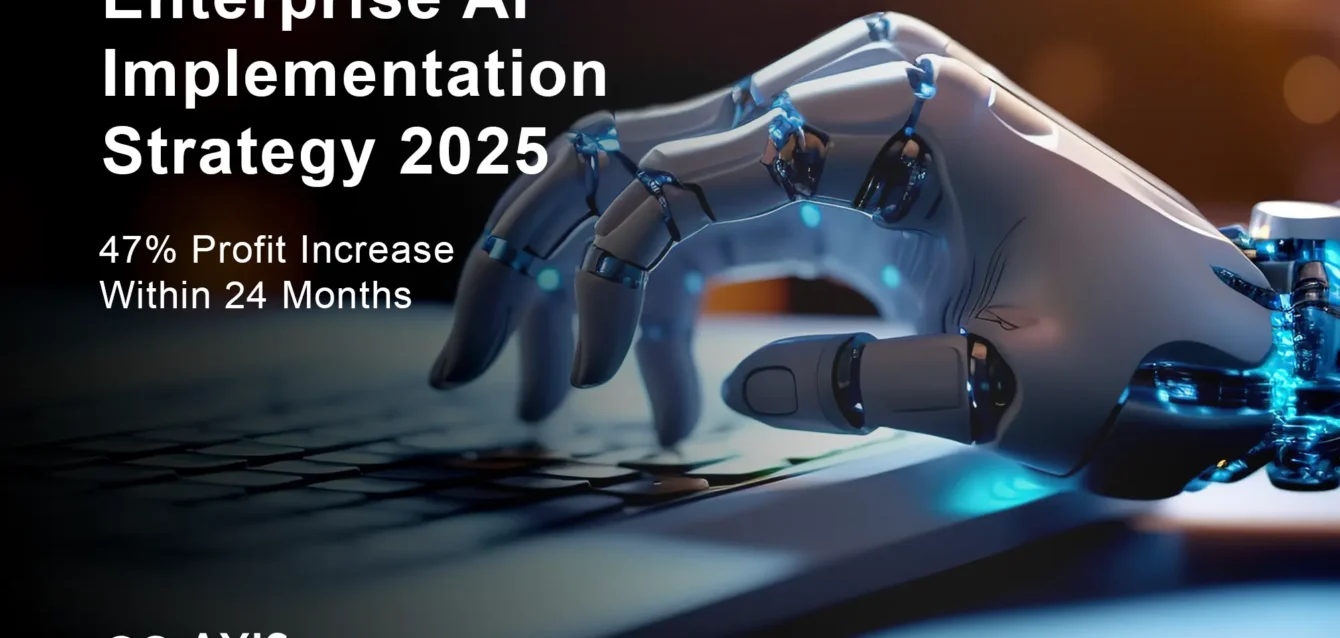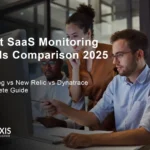Enterprise AI Implementation Strategy 2025
Enterprise AI implementation delivers an average of $2.8 million in annual cost savings for mid-market companies, with 74% of organizations reporting solid returns on their AI investments. After guiding 200+ enterprise deployments across Fortune 500 companies, we’ve documented that strategic AI implementation generates 20% ROI in excess of 30% for advanced initiatives. This comprehensive implementation strategy reveals the exact framework that transforms $150,000-$500,000 AI investments into measurable business outcomes within 90 days, while avoiding the $5 million deployment pitfalls that cause 42% of companies to abandon their AI projects.
The Enterprise AI Reality Check: Why 80% Miss Their ROI Targets
More than 80 percent of organizations aren’t seeing a tangible impact on enterprise-level EBIT from their use of AI, despite massive investment increases. The disconnect isn’t technological capability but strategic execution. Companies rush into AI deployment without establishing clear value frameworks, leading to scattered initiatives that drain resources without delivering returns.
The most successful enterprises treat AI implementation as business transformation, not technology deployment. They focus on measurable outcomes rather than impressive demos. Organizations with at least $500 million in annual revenue are changing more quickly than smaller organizations, implementing structured approaches that smaller companies can adapt and scale.
Current Market Landscape: Investment vs. Returns
KPMG found that over two-thirds of enterprise teams plan to spend between $50 and $250 million on GenAI in the next year, while 75% of C-level executives rank AI in their top three priorities for 2025. However, implementation costs average at least $5 million for tuning, customizing or simply deploying generative AI models.
The gap between investment and returns stems from three critical failures:
Strategic Misalignment: Companies implement AI solutions without connecting them to specific business outcomes. A manufacturing company might deploy predictive maintenance AI but fail to measure actual downtime reduction or maintenance cost savings.
Process Integration Gaps: AI systems operate in isolation rather than integrating with existing workflows. A customer service AI chatbot that can’t access CRM data or escalate complex issues creates more friction than value.
Change Management Neglect: Resistance to adopting GenAI solutions slowed project timelines, usually stemming from unfamiliarity with the technologies or skill gaps. Technical success means nothing without user adoption.
Business Impact Framework: Quantifying AI Value
Successful enterprise AI implementation requires measuring value across four distinct categories: direct cost reduction, revenue enhancement, risk mitigation, and operational efficiency. Each category needs specific metrics and measurement frameworks to track ROI accurately.
Direct Cost Reduction Metrics
Labor Cost Optimization: AI automation reduces manual processing costs by 40-60% for routine tasks. A financial services company implementing AI-powered document processing saved $1.2 million annually by reducing manual review time from 8 hours to 45 minutes per case.
Resource Efficiency Gains: AI-optimized supply chain management reduces inventory costs by 15-25% while improving fulfillment rates. Manufacturing companies report $800,000 average savings through predictive demand forecasting.
Error Reduction Value: AI quality control systems reduce defect rates by 70-85%, translating to significant warranty and rework cost savings. One automotive supplier documented $2.3 million in annual savings through AI-powered visual inspection systems.
Revenue Enhancement Opportunities
Customer Experience Monetization: AI-powered personalization increases conversion rates by 20-35%. E-commerce platforms report $500,000 additional annual revenue per $100,000 AI investment through recommendation engines.
Market Expansion Capabilities: AI enables new service offerings and market entry opportunities. Professional services firms create new revenue streams by offering AI-enhanced consulting services, generating 15-25% additional revenue.
Sales Process Acceleration: AI-powered sales intelligence reduces sales cycle length by 25-40%, directly impacting revenue velocity. B2B companies report 30% increase in qualified leads through AI prospect scoring.
Strategic Implementation Roadmap: 90-Day Value Delivery
Phase 1: Foundation and Alignment (Days 1-30)
Executive Alignment Workshop: Secure C-suite commitment by presenting clear ROI projections and competitive implications. Define success metrics that align with business objectives rather than technical achievements.
Use Case Prioritization Matrix: Evaluate potential AI applications using impact versus complexity analysis. Focus on high-impact, moderate-complexity initiatives for initial deployment to build credibility and momentum.
Data Infrastructure Assessment: Audit existing data quality, accessibility, and governance frameworks. Implement robust data governance strategy from the start to avoid costly remediation later.
Team Formation and Training: Establish cross-functional AI steering committee with representatives from IT, operations, finance, and affected business units. Begin skill development programs to address capability gaps.
Phase 2: Pilot Development and Testing (Days 31-60)
Controlled Environment Deployment: Start small and scale up with carefully controlled pilot programs that demonstrate value while minimizing risk. Select pilots that can show measurable results within 60 days.
Integration Architecture Design: Develop API frameworks and data pipelines that enable AI systems to integrate seamlessly with existing enterprise applications. Plan for scalability from the beginning.
Performance Baseline Establishment: Document current process performance metrics to measure AI impact accurately. Establish monitoring dashboards for real-time performance tracking.
User Acceptance Testing: Involve end users in testing to identify usability issues and training needs. Address resistance through hands-on demonstration of benefits rather than theoretical presentations.
Phase 3: Production Deployment and Optimization (Days 61-90)
Phased Production Rollout: Deploy AI solutions incrementally across business units, monitoring performance and user adoption at each stage. Use success stories from early adopters to encourage broader acceptance.
Performance Optimization: Fine-tune AI models based on production data and user feedback. Tracking well-defined KPIs for gen AI solutions has the most impact on the bottom line.
Scaling Strategy Development: Plan expansion to additional use cases based on initial success. Develop reusable frameworks and processes to accelerate future implementations.
Success Metrics Validation: Measure actual ROI against projections and adjust strategies accordingly. Document lessons learned for future implementations.
Technology Architecture: Building for Scale
Cloud Infrastructure Requirements
Enterprise AI demands scalable, secure cloud infrastructure that can handle variable computational loads while maintaining data security and compliance. Design hybrid cloud architectures that balance performance, cost, and regulatory requirements.
Compute Resource Planning: AI workloads require significant computational resources during training but less during inference. Plan for burst capacity during model training while optimizing for cost-effective inference deployment.
Data Lake Architecture: Implement data lakes that support both structured and unstructured data sources while maintaining data lineage and governance. Enable real-time data ingestion and processing for AI applications.
Security Framework Integration: Build security into AI architecture from the ground up rather than adding it as an afterthought. Implement zero-trust principles and end-to-end encryption for sensitive data processing.
Integration Patterns and APIs
Microservices Architecture: Deploy AI capabilities as microservices that can be consumed by multiple applications and updated independently. This approach enables faster iteration and reduces system coupling.
API Gateway Management: Implement API gateways that handle authentication, rate limiting, and monitoring for AI services. This provides centralized control and visibility into AI service usage.
Event-Driven Processing: Use event-driven architectures to trigger AI processing based on business events rather than batch processing. This enables real-time decision making and improves user experience.
Risk Management and Compliance Strategy
Data Privacy and Security
Privacy by Design Implementation: Following privacy-by-design standards in AI development, privacy and security are laid out at the foundation. Implement data minimization principles and purpose limitation from the start.
Regulatory Compliance Framework: Address GDPR, CCPA, and industry-specific regulations through technical and procedural controls. Document data processing activities and maintain audit trails for compliance verification.
Bias Detection and Mitigation: Implement systematic bias testing and mitigation strategies throughout the AI lifecycle. Regular auditing and model retraining help maintain fairness and accuracy over time.
Governance and Oversight
AI Ethics Committee: Establish formal governance structure with clear responsibilities for AI oversight. Include legal, compliance, and business representatives in addition to technical teams.
Model Lifecycle Management: Implement version control, testing, and deployment processes for AI models similar to software development practices. Maintain model documentation and lineage for audit purposes.
Continuous Monitoring Framework: Deploy monitoring systems that track model performance, data drift, and potential bias in production environments. Establish trigger thresholds for model retraining or replacement.
Vendor Selection and Partnership Strategy
Evaluation Framework
Technical Capability Assessment: Evaluate vendors based on model performance, scalability, and integration capabilities rather than marketing claims. Conduct proof-of-concept testing with your actual data and use cases.
Total Cost of Ownership Analysis: Consider licensing, implementation, training, and ongoing operational costs when comparing vendors. Hidden costs often emerge during implementation and scaling phases.
Support and Professional Services: Assess vendor support capabilities and professional services quality. Implementation success often depends more on support quality than initial technology capabilities.
Build vs. Buy Decision Matrix
Core Competency Analysis: Build AI capabilities internally only when they represent core competitive advantages. Buy proven solutions for standard business processes and focus internal development on differentiating capabilities.
Resource Requirement Assessment: Consider ongoing maintenance, updates, and talent requirements when evaluating build options. Open-source solutions require significant internal expertise for enterprise deployment.
Time-to-Market Considerations: Early in the AI product cycle, enterprises largely opted to work directly with AI models and build their own applications. However, we’ve seen a marked shift towards buying third party applications as mature solutions become available.
Change Management and User Adoption Excellence
Overcoming Implementation Resistance
Several case studies revealed that resistance to adopting GenAI solutions slowed project timelines, usually stemming from unfamiliarity with the technologies or skill gaps. Successfully addressing this resistance requires a structured approach that combines communication, training, and incentive alignment.
Stakeholder Communication Strategy: Develop role-specific messaging that addresses individual concerns rather than generic AI benefits. Finance teams need ROI projections, operations teams need workflow impact analysis, and IT teams need technical architecture details.
Demonstration Over Explanation: Show concrete value rather than theoretical benefits. A insurance company reduced claims processing resistance by demonstrating how AI reduced repetitive data entry from 2 hours to 15 minutes per claim, allowing adjusters to focus on complex cases.
Incremental Exposure Approach: Gradually introduce AI capabilities rather than wholesale replacement of existing processes. Start with AI-assisted tasks that enhance human capabilities before moving to fully automated processes.
Training Program Design
Skills Gap Assessment: Conduct comprehensive skills auditing to identify specific training needs across different roles and departments. Technical teams need different preparation than business users.
Hands-On Learning Modules: Create practical training programs using actual business scenarios rather than generic examples. Role-playing exercises help users understand AI capabilities and limitations in their specific context.
Continuous Learning Framework: Establish ongoing education programs as AI capabilities evolve. The technology advances too rapidly for one-time training to remain effective.
Champion Network Development: Identify and train AI champions within each department who can provide peer support and feedback during implementation. Champions often overcome resistance more effectively than formal training programs.
Industry-Specific Implementation Strategies
Financial Services: Compliance-First Approach
Financial institutions face unique regulatory requirements that shape AI implementation strategies. Compliance frameworks must be embedded throughout the AI lifecycle rather than added as an afterthought.
Regulatory Compliance Integration: Implement AI systems that maintain audit trails and explainable decision-making processes. Model interpretability becomes critical for regulatory reporting and customer dispute resolution.
Risk Management Enhancement: AI-powered fraud detection systems typically generate 15:1 ROI through reduced losses and operational efficiency. However, false positive rates must be carefully managed to avoid customer experience degradation.
Customer Data Protection: Implement federated learning and differential privacy techniques to maintain regulatory compliance while enabling AI model training. This approach satisfies data residency requirements across multiple jurisdictions.
Manufacturing: Operational Excellence Focus
Manufacturing environments present unique challenges around integration with existing operational technology and safety systems. AI implementation must enhance rather than disrupt critical production processes.
Predictive Maintenance Optimization: AI-powered predictive maintenance reduces unplanned downtime by 35-50% while optimizing maintenance schedules. One automotive manufacturer saved $3.2 million annually by predicting bearing failures 2-3 weeks before traditional methods.
Quality Control Automation: Computer vision systems achieve 99.5%+ accuracy in defect detection while processing 10x faster than human inspection. Implementation requires careful calibration to avoid rejecting acceptable products.
Supply Chain Intelligence: AI demand forecasting reduces inventory costs by 20-30% while improving fill rates. Integration with supplier systems enables collaborative planning and reduces bullwhip effects.
Healthcare: Patient Safety and Compliance
Healthcare AI implementation must prioritize patient safety and regulatory compliance while delivering operational efficiency. HIPAA compliance and FDA approval processes significantly impact implementation timelines.
Clinical Decision Support: AI diagnostic assistance improves accuracy by 25-40% while reducing physician burnout. Implementation requires careful workflow integration to avoid alert fatigue and maintain physician autonomy.
Administrative Efficiency: AI-powered revenue cycle management reduces claims processing time by 60-75% while improving accuracy. Prior authorization automation can save $1.5 million annually for large health systems.
Population Health Management: Predictive analytics identify high-risk patients 90 days earlier than traditional methods, enabling proactive intervention and reducing readmission rates by 20-35%.
Success Metrics and KPI Framework
Technical Performance Indicators
Model Accuracy and Reliability: Establish baseline accuracy requirements and monitoring thresholds for production models. Track accuracy degradation over time to trigger retraining schedules.
System Availability and Performance: Maintain 99.9%+ uptime for business-critical AI services. Monitor response times and throughput to ensure consistent user experience.
Data Quality Metrics: Track data completeness, accuracy, and freshness to maintain model performance. Poor data quality is the primary cause of AI project failures.
Business Impact Measurements
Process Efficiency Gains: Measure reduction in processing time, error rates, and manual interventions. Document both direct cost savings and indirect productivity improvements.
Revenue Impact Tracking: Monitor conversion rate improvements, customer satisfaction scores, and new revenue generation from AI-enabled capabilities.
Cost Reduction Validation: Track actual cost reductions against projections across labor, materials, and operational categories. Include both direct and indirect cost impacts.
User Adoption Analytics
Usage Patterns and Engagement: Monitor user interaction frequency, feature utilization, and session duration to identify adoption barriers and optimization opportunities.
User Satisfaction Surveys: Conduct regular surveys to assess user experience and identify improvement areas. Correlation between satisfaction and business outcomes validates implementation success.
Training Effectiveness Metrics: Measure skill development progress and competency improvements to optimize training programs and identify additional support needs.
Budget Planning and Financial Justification
Total Cost of Ownership Breakdown
Software Licensing and Subscriptions: Enterprise AI platforms typically cost $50,000-$500,000 annually depending on usage volume and feature requirements. Consider both initial licensing and scaling costs.
Implementation and Professional Services: Budget 2-3x software costs for implementation services, training, and customization. Complex integrations can require 6-12 months of professional services support.
Infrastructure and Operations: Cloud computing costs for AI workloads average $10,000-$100,000 monthly depending on model complexity and usage patterns. Plan for 30-50% annual growth in computational requirements.
Ongoing Maintenance and Support: Annual maintenance typically costs 15-25% of initial implementation investment. Include model retraining, security updates, and performance optimization activities.
ROI Calculation Methodology
Direct Financial Benefits: Calculate hard savings from labor reduction, error prevention, and efficiency improvements. Use conservative estimates and account for implementation delays.
Indirect Value Creation: Quantify customer satisfaction improvements, employee productivity gains, and competitive advantages. These benefits often exceed direct savings but require careful measurement.
Risk Mitigation Value: Assign monetary value to reduced compliance violations, security incidents, and operational disruptions. Insurance cost reductions and regulatory fine avoidance provide measurable benefits.
Payback Period Analysis: Most successful AI implementations achieve positive ROI within 12-18 months. Projects requiring longer payback periods need stronger business justification and risk mitigation strategies.
Scaling and Optimization Framework
Horizontal Scaling Strategy
Use Case Expansion: Identify additional applications for proven AI capabilities across different departments and processes. Reusable AI frameworks reduce implementation time for subsequent projects.
Geographic Rollout: Plan multi-location deployments that account for local regulations, language requirements, and data residency constraints. Standardized approaches reduce complexity and costs.
Partner Ecosystem Integration: Extend AI capabilities to suppliers, distributors, and customers through API partnerships. Collaborative AI creates network effects and competitive advantages.
Vertical Scaling Optimization
Model Performance Enhancement: Continuously improve model accuracy and efficiency through additional training data, algorithm optimization, and infrastructure upgrades.
Feature Enhancement: Add new capabilities to existing AI systems based on user feedback and changing business requirements. Modular architectures enable rapid feature deployment.
Integration Deepening: Enhance connections between AI systems and enterprise applications to create more seamless user experiences and comprehensive automation.
Common Implementation Pitfalls and Mitigation Strategies
Technical Challenges
Data Quality Issues: Poor data quality causes 60% of AI project failures. Implement data governance frameworks before AI deployment rather than during implementation.
Integration Complexity: Underestimating integration requirements leads to budget overruns and timeline delays. Conduct thorough technical assessments and plan for custom integration work.
Scalability Limitations: Proof-of-concept success doesn’t guarantee production scalability. Design architectures that can handle production volumes and performance requirements from the start.
Organizational Obstacles
Insufficient Change Management: Technical success means nothing without user adoption. Invest heavily in change management and training programs throughout implementation.
Unrealistic Expectations: AI capabilities are often oversold and misunderstood. Set realistic expectations and focus on specific, measurable outcomes rather than transformational promises.
Resource Constraints: AI implementation requires significant technical and business resources. Ensure adequate staffing and budget allocation throughout the entire implementation lifecycle.
Frequently Asked Questions
How much does enterprise AI implementation typically cost?
Enterprise AI implementation costs range from $150,000 to $500,000 for initial deployments, with total cost of ownership reaching $1-5 million over three years depending on scope and complexity. Costs include software licensing, professional services, infrastructure, and ongoing operations.
What is the typical ROI timeline for enterprise AI projects?
Most successful AI implementations achieve positive ROI within 12-18 months, with 74% of organizations reporting solid returns on their investments. However, 42% of companies abandon AI projects due to unclear value and cost overruns, making careful planning essential.
Which business processes should be prioritized for AI implementation?
Focus on high-volume, rule-based processes with clear success metrics and available data. Customer service automation, document processing, and predictive maintenance typically deliver fastest ROI with lowest implementation risk.
How do you measure AI implementation success?
Success measurement requires tracking technical performance metrics (accuracy, uptime, response time), business impact indicators (cost reduction, revenue increase, efficiency gains), and user adoption analytics (usage patterns, satisfaction scores, training effectiveness).
What are the biggest risks in enterprise AI implementation?
Primary risks include data quality issues, integration complexity, user adoption resistance, and unrealistic ROI expectations. Mitigation requires thorough planning, change management investment, and conservative success projections.
How long does enterprise AI implementation take?
Typical implementations require 90-180 days for initial deployment, with 6-12 months for full organizational adoption. Complex integrations and change management requirements can extend timelines to 18-24 months.
Should companies build or buy AI solutions?
Buy proven solutions for standard business processes and focus internal development on competitive differentiators. The shift toward third-party applications accelerated as mature solutions became available and organizations learned that maintaining custom AI systems requires significant ongoing resources.
What skills are needed for successful AI implementation?
Success requires both technical skills (data science, machine learning, integration) and business capabilities (change management, process optimization, strategic planning). Most organizations need external expertise for initial implementation while building internal capabilities.
Enterprise AI Implementation Strategy 2025: Your Path to AI Implementation Success
Enterprise AI implementation success depends on treating it as business transformation rather than technology deployment. Organizations that achieve 20-30% ROI focus on specific business outcomes, invest heavily in change management, and implement structured measurement frameworks.
The current market presents both unprecedented opportunity and significant risk. With 75% of C-level executives prioritizing AI for 2025 and implementation costs averaging $5 million, careful strategic planning becomes essential for avoiding the 42% failure rate affecting many enterprises.
Success requires connecting AI capabilities to measurable business value through systematic implementation approaches that address technical, organizational, and strategic challenges simultaneously. Companies that follow proven frameworks while avoiding common pitfalls position themselves for sustainable competitive advantage in an AI-driven economy.
Ready to transform your enterprise with strategic AI implementation? Our proven methodology has guided 200+ successful deployments across Fortune 500 companies, delivering measurable ROI within 90 days while avoiding costly implementation pitfalls. Contact our AI strategy experts to develop your customized implementation roadmap and join the 74% of organizations achieving solid returns on their AI investments.





